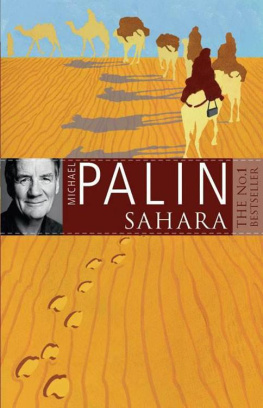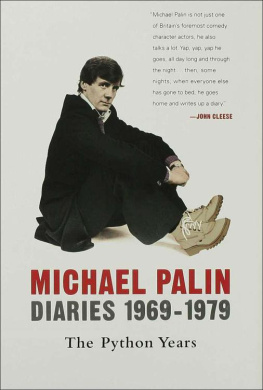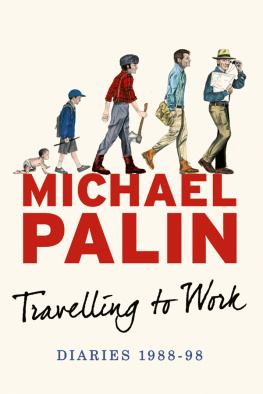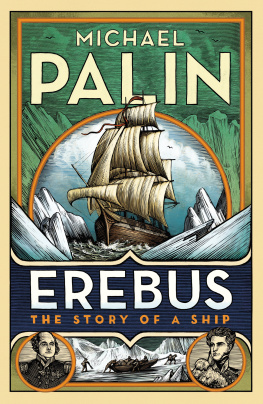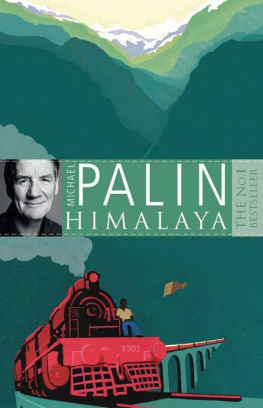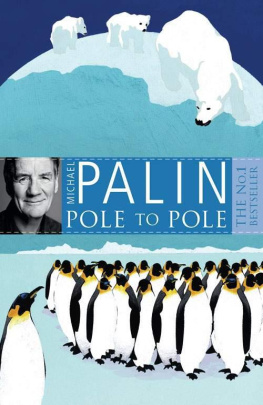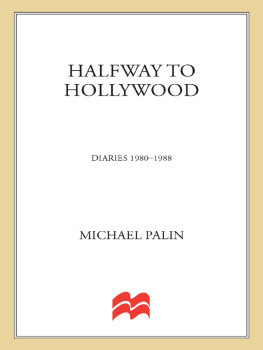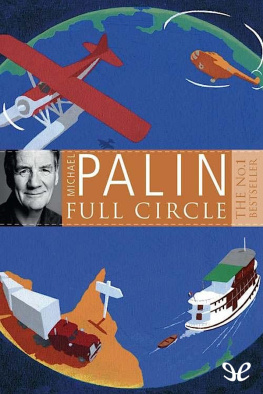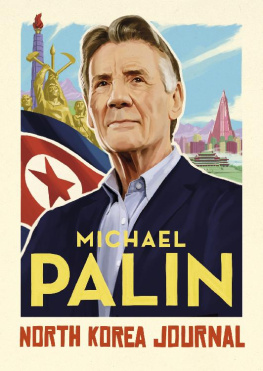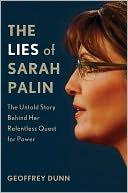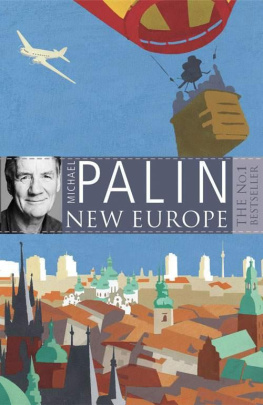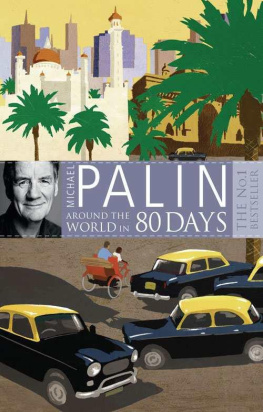MICHAEL PALIN is a scriptwriter, comedian, novelist, television presenter, actor and playwright. He established his reputation with Monty Pythons Flying Circus and Ripping Yarns . His work also includes several films with Monty Python, as well as The Missionary , A Private Function , A Fish Called Wanda , American Friends and Fierce Creatures . His television credits include two films for the BBCs Great Railway Journeys , the plays East of Ipswich and Number 27 , and Alan Bleasdales GBH .
In 2006 the first volume of his diaries, 1969-1979: The Python Years, spent several weeks on the bestseller lists. He has also written books to accompany his seven very successful travel series: Around the World in 80 Days (an updated edition of which was published in 2008, twenty years later), Pole to Pole , Full Circle , Hemingway Adventure , Sahara , Himalaya and New Europe . Most have been No 1 bestsellers and Himalaya was No 1 for 11 weeks. He is the author of a number of childrens stories, the play The Weekend and the novel Hemingways Chair . Visit his website at www.palinstravels.co.uk .
Basil Pao began his photographic career in 1980 on his return to Hong Kong after ten years in the United States, where he was an art director for Atlantic, Polygram and Warner Bros. He first worked with Michael Palin on the design for the book accompanying Monty Pythons Life of Brian . They have since collaborated on the books based on his seven travel series. In 2007 he wrote and photographed China Revealed: A Portrait of the Rising Dragon .
SAHARA
MICHAEL PALIN
Photographs by Basil Pao

A WEIDENFELD & NICOLSON EBOOK
First published in Great Britain in 2002 by Weidenfeld & Nicolson
This ebook first published in 2010 by Orion Books
Copyright (c) Michael Palin, 2002
Photographs copyright (c) Basil Pao, 2002
Original map on pp.vii-ix by Stephen Conlin
The moral right of Michael Palin to be identified as the author
of this work has been asserted in accordance with the
Copyright, Designs and Patents Act 1988.
All rights reserved. No part of this publication may be reproduced, stored in a retrieval system or transmitted in any form or by any means, without the prior permission in writing of the publisher, nor to be otherwise circulated in any form of binding or cover other than that in which it is published without a similar condition, including this condition, being imposed on the subsequent purchaser.
Quotation from p. 4 from Their Heads are Green by Paul Bowles, published by Peter Owen Ltd; on p. 111 from Travels into the Interior of Africa by Mungo Park, published by Eland Editions; on pp. 139-40 from The Strong Brown God by Sanche de Gramont, published by Houghton Mifflin Co.; on p. 209 from For the Fallen (September 1914) by Laurence Binyon, by permission of The Society of Authors as the Literary Representative of the Estate of Laurence Binyon.
A CIP catalogue record for this book
is available from the British Library.
ISBN: 978 0 2978 6359 5
The Orion Publishing Group Ltd
Orion House
5 Upper Saint Martins Lane
London WC2H 9EA
This ebook produced by Jouve, France
An Hachette UK Company
www.orionbooks.co.uk
For Helen, Tom, Will and Rachel
CONTENTS
INTRODUCTION
My father was in charge of the Export Department of a steelworks and every Christmas he received an enormous box of dates from their agent in Algeria, addressed to a Mr E. M. Palm. I remember wondering if he should tell them, but he never bothered. Perhaps he thought the supply of dates might dry up if they discovered his name wasnt Palm.
I didnt want them to stop coming either, not because of the dates, but because of the box they came in. The illustration on the packet fuelled powerfully romantic fantasies of somewhere hotter, drier and even more exotic than south Yorkshire; a place where men with turbans, baggy velvet pants and wicked moustaches reclined under palm trees with veiled and sequinned ladies, whilst their faithful camels stood in picturesque silhouette against the setting sun.
The first proper book I was ever given was Tales from the Arabian Nights . Its seductive illustrations, by A. E. Jackson, combined with the date boxes to fan a precocious fascination for things of the desert. Curved swords, soft silks, tassels and see-through skirts. Mirages and genies, huge jellies and lubricious oils and unguents. The desert world seemed, apart from the odd beheading, to be a place of complete sensual fulfilment. Even delight itself was Turkish.
Almost fifty years later there came a chance to expose my childhood fantasies to the harsh glare of reality.
In the first spring of the new millennium I met up with Roger Mills, director of many of the travel programmes Ive done, at a pub opposite Notting Hill police station. Over a pint or two he suggested a journey through Francophone Africa, those huge and empty countries from Cameroon northwards, once loosely federated as part of the French empire. Rarely visited by British television, they might provide fresh pickings and new discoveries.
I got home, unfolded a map, and saw one word spread across most of these countries. Sahara.
The French empire was interesting, but it had come and gone. The Sahara is a potent, evocative reality. It is one of the worlds great brands. No one name so completely epitomises an environment. Oceans can be Atlantic or Pacific or Indian, mountains can be Himalayas or Andes or Alps, but if you want to convey desert, you only have to say Sahara.
It embodies scale and mystery, the thin line between survival and destruction, the power to take life or to transform it. A self-contained, homogenous, identifiable world, uncompromising and irreducible.
In other words, a challenge. And by no means an easy one.
As big as the United States, with a population the size of Norfolk, the Sahara is only 15 per cent sand, and though the great ergs, the sand seas, are among the most exquisitely beautiful landscapes Ive ever seen, there is a dark side. The Sahara is also a killer, scorching the life out of crops, people, and all but the most tenacious living creatures. Its growing larger every year as drought turns pasture back into sand, which the remorseless desert wind carries into towns and villages until they die of suffocation. It has its share of war and conflict. Many areas we wanted to see were inaccessible because of minefields and military activity.
Yet how close it is to us. The Sahara lies just beyond the borders of Europe. The heart of the desert is three hours flying time from Paris, four hours from London. This proximity is not lost on the many thousands of sub-Saharan Africans who cross the desert to escape what they see as poor, unstable and oppressive regimes back home.
Today, the Sahara, far from being a cosy date-box illusion, has become a bridge from Africa into Europe, and a bridge that is increasingly well used by those prepared to risk their lives for a better life on the other side of the Mediterranean. If the Sahara was my fantasy, Europe is theirs. Perhaps they will learn from their journey, as I did from mine, that fantasy and experience never quite match up.
Michael Palin, London, 2002
www.palinstravels.co.uk

Sahara was filmed between February 2001 and February 2002. For various reasons, it was impossible to shoot it as one continuous journey. Summer heat and all-year-round bureaucracy forced a number of breaks upon us. The diary days in the text represent days at work, give or take the very rare day off, and not time spent travelling out to the desert .
Next page
